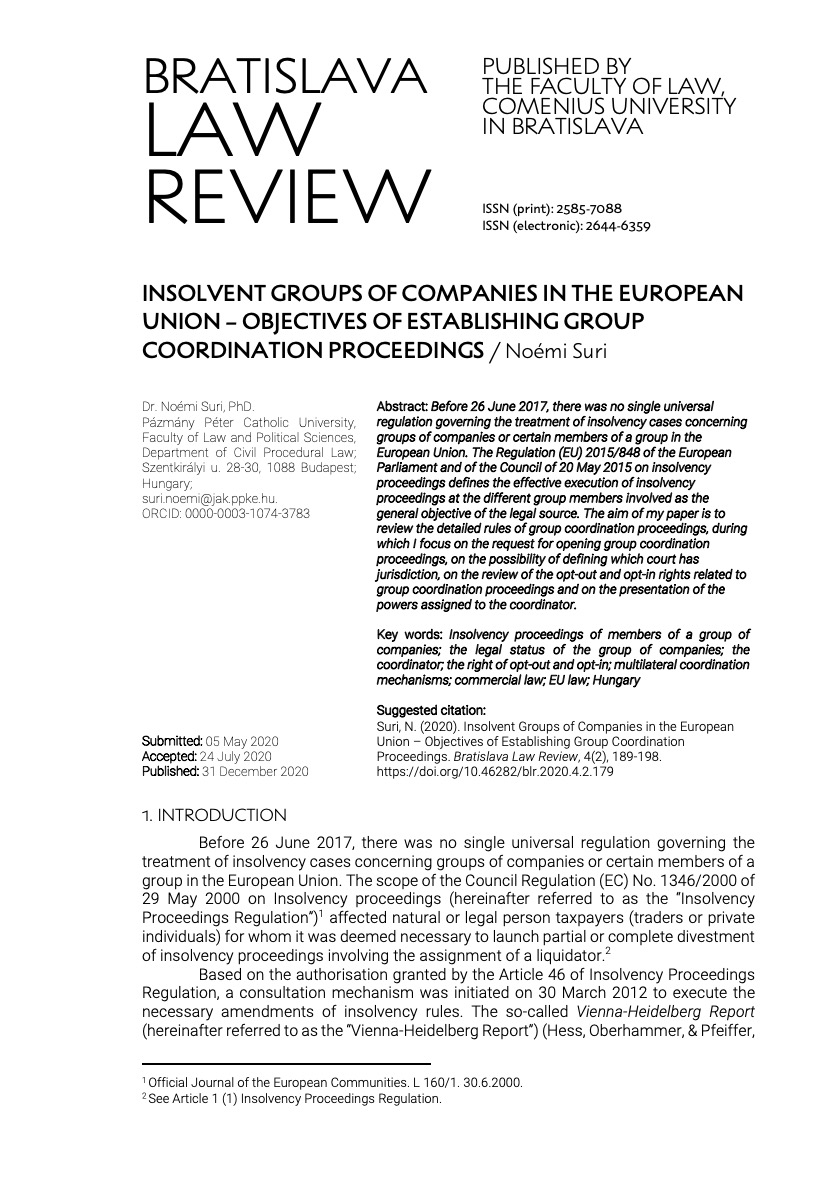Insolvent Groups of Companies in the European Union
Objectives of Establishing Group Coordination Proceedings
DOI:
https://doi.org/10.46282/blr.2020.4.2.179Keywords:
Insolvency proceedings of members of a group of companies, the legal status of the group of companies, the coordinator, the right of opt-out and opt-in, multilateral coordination mechanisms, commercial law, EU law, HungaryAbstract
Before 26 June 2017, there was no single universal regulation governing the treatment of insolvency cases concerning groups of companies or certain members of a group in the European Union. The Regulation (EU) 2015/848 of the European Parliament and of the Council of 20 May 2015 on insolvency proceedings defines the effective execution of insolvency proceedings at the different group members involved as the general objective of the legal source. The aim of my paper is to review the detailed rules of group coordination proceedings, during which I focus on the request for opening group coordination proceedings, on the possibility of defining which court has jurisdiction, on the review of the opt-out and opt-in rights related to group coordination proceedings and on the presentation of the powers assigned to the coordinator.Before 26 June 2017, there was no single universal regulation governing the treatment of insolvency cases concerning groups of companies or certain members of a group in the European Union. The Regulation (EU) 2015/848 of the European Parliament and of the Council of 20 May 2015 on insolvency proceedings defines the effective execution of insolvency proceedings at the different group members involved as the general objective of the legal source. The aim of my paper is to review the detailed rules of group coordination proceedings, during which I focus on the request for opening group coordination proceedings, on the possibility of defining which court has jurisdiction, on the review of the opt-out and opt-in rights related to group coordination proceedings and on the presentation of the powers assigned to the coordinator.
References
Bornemann, A. (2016). Verfahren über Mitglieder einer Unternehraensgruppe – Konzerninsolvenzrecht. In K. Wimmer, A. Bornemann, & M. Lienau (Eds.), Die Neufassung der EuInsVO (1st ed., pp. 174–228). Köln: Luchterhang Verlag.
Hess, B., Oberhammer, P. and Pfeiffer, T. (2014). External evaluation of Regulation N°1346/2000/EC on Insolvency Proceedings. Retrieved from Universität Wien; Ruprecht-Karls-Universität: https://op.europa.eu/en/publication-detail/-/publication/4d756fa7-b860-4e36-b1f8-c6640dced486#
Jaufer, C. (2017). Konzerninsolvenz nach der EuInsVO 2015. In T. Garber, C. Jaufer, & B. Nunner-Krautgasser (Eds.), Grenzüberschreitende Insolvenzen im europäischen Binnenmarkt. Die neue EU-Insolvenzverordnung. Wien: MANZ Verlag Wien.
Mangano, R. (2016). Group Insolvencies. In R. Bork & R. Mangano (Eds.), European Cross-Border Insolvency Law (1st ed., pp. 273–299). Oxford University Press.
Oberhammer, P., Koller, C., Auernig, K. and Planitzer, L. (2017). Insolvencies of groups of companies. In S. Bariatti, B. Hess, C. Koller, B. Laukemann, P. Oberhammer, M. Requejo Isidro, & F. C. Villata (Eds.), The Implementation of the New Insolvency Regulation (1st ed., pp. 185–226). Hart/Nomos. Retrieved from https://doi.org/10.5040/9781509921300.part-003
Reinhart, S. (2016). Nachträgliches Opt-in durch Verwalter (Art 69 VO (EG 2015/848). In H.-P. Kirchhof, H. Eidenmüller, & R. Stürner (Eds.), Münchener Kommentar zur Insolvenzordnung (pp. 504–507). München: Verlag C. H. Beck.
Veress, E. (2019). A román fizetésképtelenségi jog alapjai. Gazdaság És Jog, 27(4), 15–19.
Wessels, B. (2017). Insolvency proceedings of members of a group of companies. In International Insolvency Law. Part II European Insolvency Law (4th ed., pp. 671–732). Deventer: Wolters Kluwer (Netherlands).

Downloads
Published
Issue
Section
Categories
License
Copyright (c) 2020 Bratislava Law Review

This work is licensed under a Creative Commons Attribution-NonCommercial-NoDerivatives 4.0 International License.
The Author(s) transfers copyright to the Article to the Publisher of the Journal by the Licence Agreement.
The Author(s) retains rights specified in the Licence Agreement.
The readers may read, download, copy, distribute, print, search, or link to the full texts of all of the Article of the Journal and use them for any other lawful purpose under specified Creative Commons Licence (CC BY-NC-ND 4.0).











